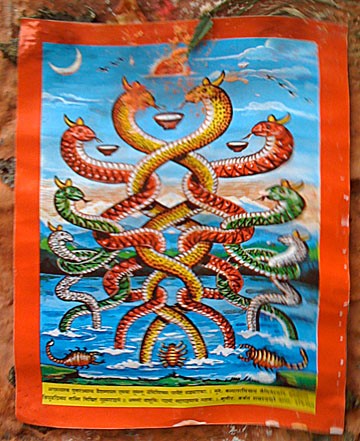Biodiversity Conservation and Traditional Culture in Nepal
- gybn.web
- Aug 27, 2020
- 3 min read
Updated: Aug 28, 2020
Biodiversity loss is tragic and is increasing in an alarming rate. The loss in the biodiversity leads to a breakdown in the functioning of ecosystems. As biodiversity has major roles in Earth's ecosystems, we need to conserve biodiversity for our own existence. Traditional culture and biodiversity are closely related; religious, cultural and traditional rituals and rules makes this relation stronger and also are characterized as conservation ethic. Nepal is rich in biodiversity and culture, and therefore the role of cultural importance in biodiversity protection exists.
Conservation has become a part of Hindu life. According to Hindu theology, there are five important elements of life i.e. space, air, fire, water and earth. These elements are also believed to be connected with the five sensory organs (nose to earth, tongue to water, eyes to fire, skin to air and ears to space ). This explains the relationship that humans have with nature. Hinduism teaches the worshipping of nature, including the worshipping of rivers, mountains, plants, animals and earth. Buddhism and Jainism also follow a similar path for the protection of plants, animals, birds, etc.
Some Nepali culture and rituals related with biodiversity conservation are as follows:
Naag Panchami
Naag Panchami is a day of the traditional worship of snakes by Hindus. Live snakes, mainly cobras or statues of snakes are worshipped on this day. Devotees put a picture of Nags above their doorway. Nags are deity snakes according to Hindu mythology. Offerings are left in the yards and paddies for snakes. Killing snakes are considered a sin in Hindu mythology, which also helps in biodiversity conservation.
Picture Source: Google
Bel bibaha
Women belonging to the Newari community in Nepal get married at least three times in her entire life. Bel bibaha is the first ceremony where preadolescent Newari girls get symbolically married to bel fruit (wood apple).

Girl from Newari community getting married to bel (wood apple)
Picture source: Google
This fruit is considered a symbol of the God Bishnu (Hindu God). After Bel bibaha, Newari women are also married to the Sun. In Newari culture, it is believed that a woman is not considered a widow even if her husband passes away, since they are also married to the God Bishnu and the Sun. This connection shows the foundation of the Newari relationship with nature.
Dog Festival (Kukur tihar)
Kukur tihar is the festival celebrated in Nepal where dogs are worshipped. This festival is dedicated solely for thanking dogs for their loyalty and friendship. People decorate dogs with flower garlands and offer them food to acknowledge the relationship between humans and dogs. Dogs are believed to be messengers of Lord Yamaraj (the God of death in Hindu mythology).

Picture source: Google
Tulsi bibah (Tulsi weeding) Tulsi (Ocimum tenuiflorum) weeding is performed in the Hindu community of Nepal. The ceremonial connection of Tulsi (holy basil) plant is done with Hindu god Shaligram or Vishnu. This connection signifies the end of the monsoon and the beginning of the wedding season in the Hindu community. The Tulsi plant also has a lot of medicinal importance as well as its production of oxygen twenty hours a day and ozone production four hours a day. It also forms nascent oxygen which is useful in absorbing harmful greenhouse gases like carbon monoxide, carbon dioxide and sulfur dioxide from the environment. This tradition helps the conservation of the Tulsi plant and also promotes the declination of environmental pollution.

Tulsi bibah being performed in Hindu community
Picture source: Google
This traditional activity shows a close connection between religion, ecology and ethical values. In addition to the above mentioned cultural and traditional rituals, there are many other rituals existing in Nepalese society. Worshipping of trees like the Banyan tree (Ficus religiosa), the use of mango leaves in every holy ritual, the usage of sandal wood, encircling trees with sacred thread, and other traditions shows the necessity of trees for continuing rituals and also supporting biodiversity conservation. The connections between traditional beliefs and the protection of nature make sense and emphasizes a sustainable approach for the biodiversity conservation.
Pratik Baral
BSc Environmental Science, Fourth Year
Department of Environmental Science and Engineering, Kathmandu University












Become a member of Dubai Chamber of Commerce to access smart solutions, exclusive networking, awards programmes, and global growth.
business networking in dubai
corporate service providers
ESG label
Everything in Sprunked, from the layout to the sounds, radiates a sense of fun. Instead of overwhelming tutorials, you learn by doing, unveiling new aural treats with each scratch. I’m constantly motivated to explore and refine. Whether I’m building a quick loop or a full-fledged composition, it remains a delightful process.